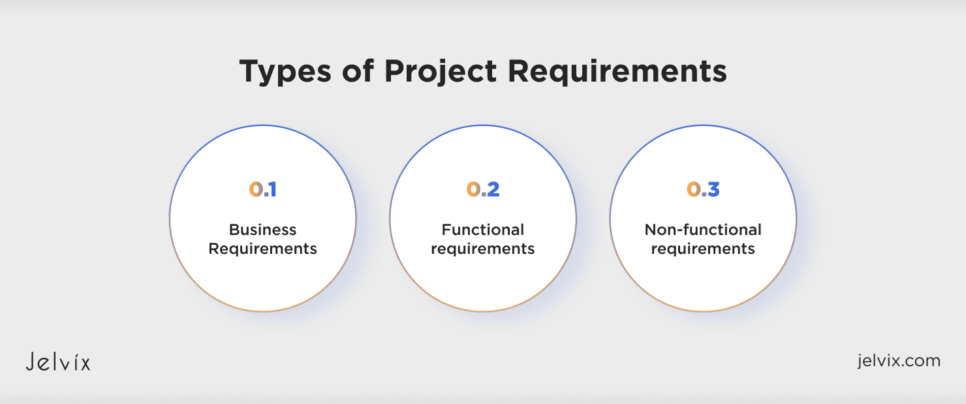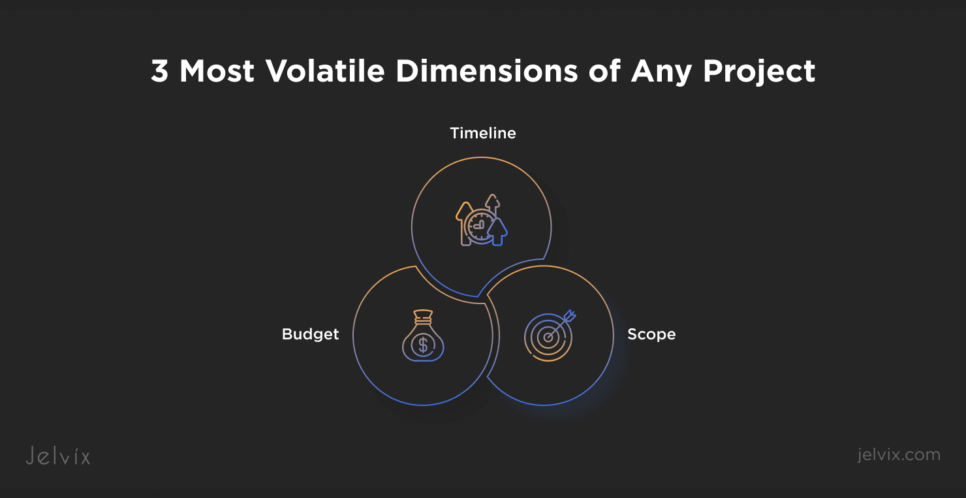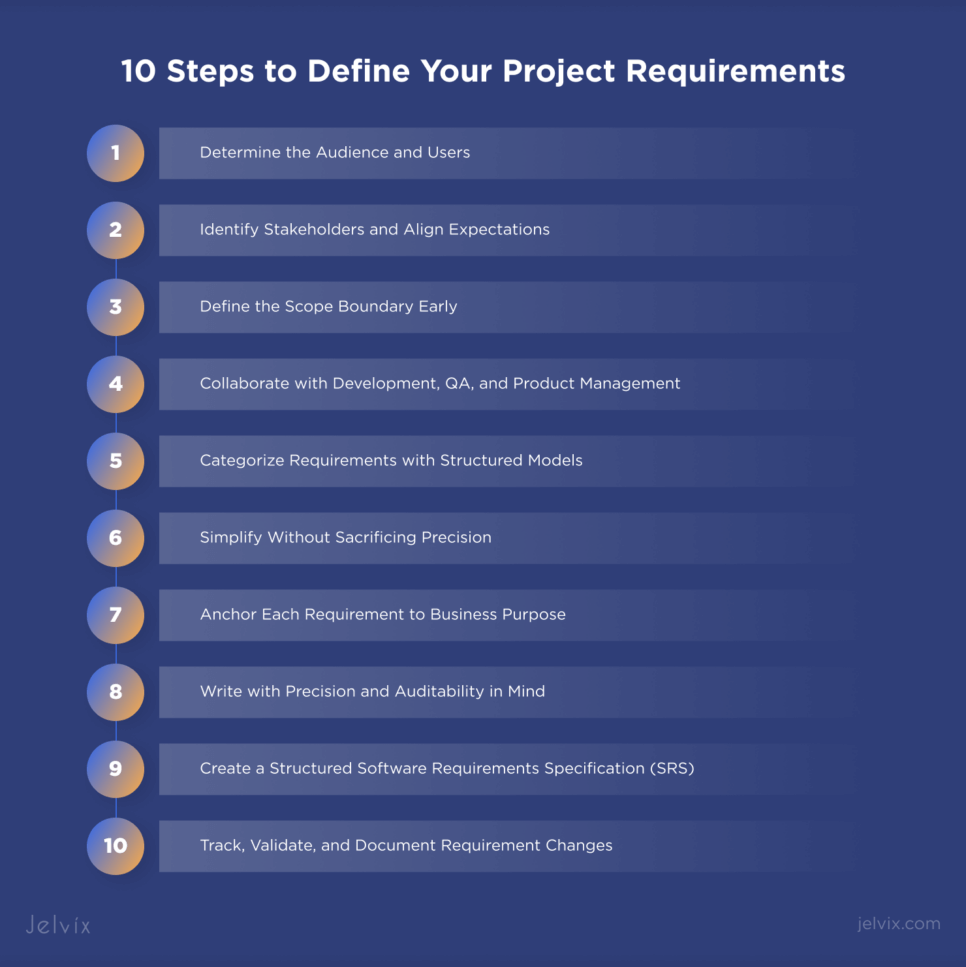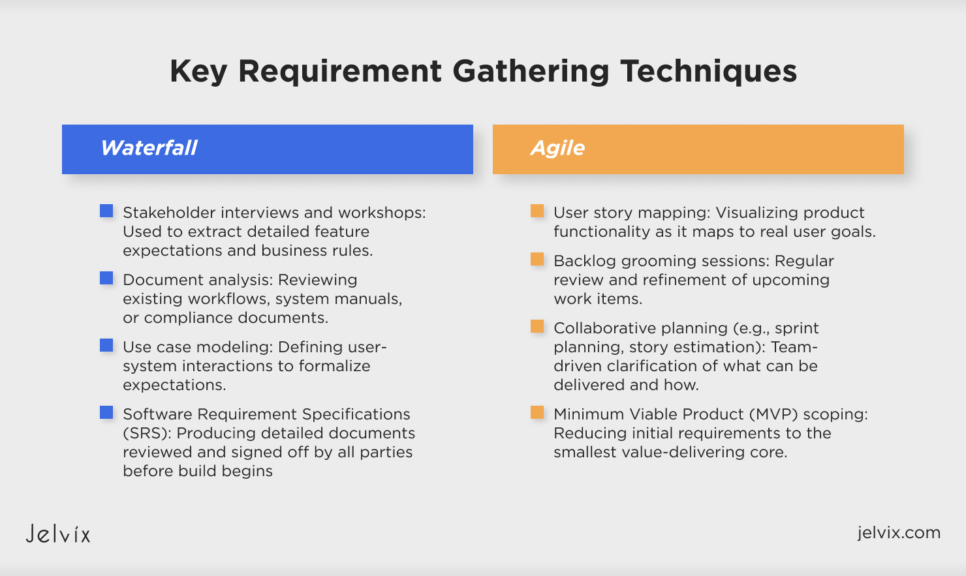Even with today’s tools and methodologies, nearly 70% of projects still fail to meet their original goals, according to the McKinsey Report. The culprit isn’t a lack of talent or technology—it’s a poor definition of project requirements. Without a clear foundation, even the most sophisticated projects can quietly veer off course, draining resources, frustrating teams, and leaving stakeholders with little to show for months of effort.
For project managers, the gap between an idea and a delivered solution is often littered with shifting priorities and half-defined objectives. One misinterpreted project requirements example at the outset can trigger a ripple effect—missed deadlines, strained budgets, or rework that blindsides even seasoned teams.
Worse, many teams jump into execution without employing proven requirement-gathering techniques, treating early discussions as “good enough” instead of mission-critical. But vague goals aren’t just inconvenient; they are structural faults that undermine entire initiatives.
In this guide, we’ll break down 11 practical steps that transform requirement gathering from a checkbox activity into a strategic weapon. With the right approach, you’ll move beyond assumptions, build airtight project requirements, and set your team on a path toward measurable, resilient success.
What Are Project Requirements?
Project requirements define the measurable conditions a solution must satisfy to be considered complete. They typically fall into categories such as functional (specific system behaviors), non-functional (performance, scalability, usability standards), business rules (governing logic), and constraints (regulatory, technical, or operational limits). Together, they form a binding framework that governs development, testing, and delivery.
In real-world environments, learning how to write requirements means simultaneously mastering functional specification writing, risk identification, interface mapping, and user expectation management—many disciplines at once. Documentation project management is about building durable, actionable agreements that development, QA, and stakeholder teams can independently confirm without perpetual clarifications.
A disciplined requirements development method isolates fixed engineering demands from erratic user opinions. It turns corporate goals into system capabilities, ranks outcomes above features, and finds latent technological debts before they spread. Not only do poorly defined requirements cause teams to engineer blindfolded, retrofit important features midstream, and accept erratic quality levels as unavoidable, but they also slow down delivery.
Types of Project Requirements
Project requirements are not a monolith. Each category has a different use and calls for different validation methods. Building documentation that resists inspection by technical teams, stakeholders, and regulatory authorities depends on recognizing the differences.
Business Requirements express the high-level objectives and value propositions behind the project. They convert leadership intent into concrete goals, like a 15% operational efficiency increase or platform support expansion for new client segments. Usually found in business requirement papers (BRDs), these form the strategic guide for downstream planning.
Functional requirements define exactly how a system must function to satisfy those corporate needs. With accuracy, they outline system features, processes, data management, and user interactions. Two such examples are “the system must encrypt user passwords at rest using AES-256” and “the platform must support concurrent sessions for up to 10,000 users.” Well-written functional requirements let business analysts, testers, and developers operate free from interpreting assumptions.
Non-functional requirements govern the environment under which the system has to run. They cover performance benchmarks, security criteria, compliance mandates, scalability goals, and availability caps. Often more precisely than core functionality itself, non-functional metrics like “99.99% uptime,” “response time under 200ms for critical transactions,” or “GDPR compliance across all user data processes” determine project success.
Why Project Requirements Matter
Project requirements are not an administrative formality; they are the architectural foundation on which project success is engineered. A robust project requirements document (PRD) directly impacts the three most volatile dimensions of any project:
- Timeline;
- Budget;
- Scope.
Without well-stated rules, plans start to become speculative rather than strategic. The CHAOS Report of the Standish Group indicates that in 35% of situations, insufficient requirements are the main reason a project fails. Teams estimate development effort based on vague assumptions, which leads to serial timeline adjustments once the real complexity surfaces mid-execution. PMI notes on the financial side that 47% of projects have budget overruns, most typically resulting from rework, late-stage change requests, and extra testing cycles not scoped in the initial financial plan.
Usually taken lightly in early discussions, scope becomes an evolving target without obvious control. Requirements gathering tools like JIRA, Confluence, or dedicated RM platforms offer mechanisms for locking scope boundaries, tracking changes through version-controlled artifacts, and preventing uncontrolled feature creep. Yet without disciplined use, even the best tools simply record the chaos instead of preventing it.
Inaccurate description of demands multiplies with time. Unchecked early misunderstandings spread into mismatched deliverables, unhappy stakeholders, regulatory compliance issues, and technical debt needing a sophisticated re-engineering solution. A PRD not only specifies what is constructed but also protects the project against often late silent failure modes that would otherwise be too costly to properly address.
10 Steps To Define Your Project Requirements
Precision in project requirements doesn’t happen accidentally; it requires deliberate effort, structured conversations, and professional documentation practices. Below is a technical, practical framework that guides teams and stakeholders toward building requirements that survive real-world execution pressures.
Determine the Audience and Users
Before drafting a project requirements document, teams must first define who the users are and what realities shape their expectations and behaviors.
Begin by mapping out all primary, secondary, and tertiary users.
- Primary users interact with the system daily.
- Secondary users depend on outputs but don’t engage with it directly.
- Tertiary users are those indirectly impacted (e.g., administrators, compliance officers).
Techniques like stakeholder analysis grids help prioritize which user groups must be interviewed or observed first.
When developing user personas, focus on more than basic demographics. Critical attributes include:
- Behavioral patterns and workflow models;
- Pain points and operational frustrations;
- Decision-making authority and constraints;
- Technical proficiency and device preferences;
- Environmental factors influencing system use (e.g., mobility, noise levels, regulatory context).
Apply structured approaches to collect authentic user data:
- Contextual Inquiries: Put researchers in the real world with the user to watch how they work and ask deep questions as tasks happen naturally. Great for finding hidden wants and points of contention.
- Observational Studies: Write down how current systems are actually used, including any workarounds, delays, or mistakes. They are often paired with process timing studies or video analysis.
- User Interviews: Hold semi-structured conversations with users to learn more about their needs, frustrations, and limitations.
- Surveys and Questionnaires.
- Persona Workshops: Collaborative sessions with stakeholders and users to synthesize research findings into shared, validated persona profiles.
By making the system fit these real traits, assumptions, interface mismatches, and technical rework are cut down by a large amount. Companies include persona validation checkpoints in their requirements development process to ensure that every functional and non-functional demand can be traced back to confirmed user needs.
Identify Stakeholders and Align Expectations
Teams have to find all those who have a stake in the success of the project before any productive requirement gathering can start. Who are these people, what duties do they have, and how might their decisions or feedback affect scope, budget, technical direction, or compliance? A simple stakeholder register should record these things. Clear identification at this point helps to avoid the neglect of important voices when priorities begin to conflict.
By mapping stakeholder influence and interest, one may concentrate on communication efforts. While individuals with lesser stakes can be briefed periodically, high-influence, high-interest stakeholders need close engagement. Simple influence-interest mapping guarantees that input is gathered proportionately, preventing the trap of providing identical weight to parties with quite different degrees of power or investment in the outcome.
Formal techniques such as planned stakeholder interviews, group seminars, and focused polls give consistent information when compiling requirements. Not only are feature requests to be gathered, but also expectations on the actual output of the project should be aligned. Appropriately controlled early-stage participation lays the groundwork for clear, unambiguous project requirements that withstand political changes and operational realities later in the project lifecycle.
Define the Scope Boundary Early
Scope defines the totality of work required to deliver a successful project—no more, no less. It describes the system’s intended features, functions, integrations, limitations, and external dependencies. Without clear boundaries, projects risk expanding unpredictably as new ideas, stakeholder demands, or technical surprises emerge.
Several methods provide effective formalization of scope. Context diagrams describe the interactions of the system with users, external systems, and data sources, offering a high-level perspective on it. Use case diagrams go a step deeper, capturing specific user interactions with the system in a visual, easily understandable format. By outlining what is included—and equally significantly, what is excluded—from the project, scope statements help all stakeholders to align around the same expectations.
Applying these tools prevents requirement gathering from evolving into an open-ended wishlist exercise. Rather than dispersing attention across conflicting, unfocused needs, teams work against an agreed knowledge of system limits, concentrating requirement discussions on what really advances project goals.
Collaborate with Development, QA, and Product Management
Leadership provides high-level goals, but the translation into functional system behaviors calls for strong coordination across development teams, QA engineers, DevOps, and product owners. Regular technical seminars and architectural review meetings expose edge situations and technological dependencies early on, including realism in project planning from the beginning.
Categorize Requirements with Structured Models
When teams arrange needs into logical groups, they clearly know how to develop, allocate, and test features. Fundamentally, functional requirements define what the system should be able to do—that is, how users should interact with it, how it should manage transactions and validate data. Concurrent with these criteria for operation—performance under load, system availability goals, or usability on limited devices—non-functional needs establish the conditions of operation.
Apart from these fundamental criteria, more intricate requirements models address aspects that are sometimes overlooked in the early phases of scoping. Security standards include access control, end-to-end encryption, and the ability to maintain an audit trail. Compliance gives specific areas, such as managing GDPR data or being ready for a HIPAA audit, legally binding duties. Complicated tech stacks also need systems to monitor interaction points, such as outdated protocols or third-party dependencies that are impossible to eliminate.
Clear categorization of these requirements facilitates adaptable planning. It reduces interdependent noise, clarifies ownership across teams, and facilitates the finding of things during validation. When teams have to make tough decisions, these ordered groupings help them set priorities based on logic. This makes it easier to protect core system behavior even when other areas need to be changed.
Simplify Without Sacrificing Precision
Although documentation for complicated projects is sometimes quite extensive, well-written standards should nonetheless be simple to grasp without sacrificing their technical rigor. Project requirements templates help professional teams to provide structure, clarify any uncertainty, and expedite the approval process. Templates help to ensure consistency in documentation while also allowing for more flexible technical readings.
Effective templates include:
- Template for the IEEE 830 Software Requirements Specification (SRS): A common framework for organizing requirements into functional, non-functional, interface, and system features, along with validation criteria and tables for tracking changes.
- Volere Requirements Specification Template: Made by Suzanne and James Robertson, it has a modular structure and covers business background, stakeholder analysis, functional and non-functional requirements, and project constraints.
- Agile User Story Mapping Templates: These are used in agile settings to see how work gets done and to set priorities for projects across releases and iterations by combining epics, capabilities, features, user stories, and acceptance criteria.
Picking the right template depends on the complexity of the project, its degree of regulatory exposure, and its delivery method. Usually, for projects in regulated sectors or enterprise software development, IEEE-based models are the best option. Agile teams favor dynamic backlogs put up with Jira or Confluence templates over static papers since they are more easily altered. The goal is the same no matter the format: reduce cognitive load, standardize validation processes, and make sure that clear responsibility is maintained throughout the development lifecycle.
Anchor Each Requirement to Business Purpose
Whether it’s operational effectiveness, sales growth, or compliance enforcement, each requirement should obviously connect to a business driver. Needs that aren’t clearly connected to business value make it harder to focus on the project and are often a sign of early-stage scope pollution.
If a need calls for support for several languages, for example, the justification should relate to goals for market expansion and demonstrate how customers are expected to increase in particular areas. Real-time dashboards could be required for corporate KPIs or to clarify audits. Including this traceability information directly in your project requirements document, either in a “Business Rationale” section or a linked traceability matrix, ensures accountability during scope reviews and prioritization decisions.
Write with Precision and Auditability in Mind
In all documentation project management efforts, use clear, concise language. Avoid ambiguous verbs (“should,” “could,” “may”) unless deliberately capturing optional features. Where possible, frame requirements using the “Five Ws”—Who, What, When, Where, Why—particularly in regulatory-driven projects where audit trails are mandatory.
Create a Structured Software Requirements Specification (SRS)
A formal Structured Software Requirement Specification consolidates all functional, non-functional, business, and technical requirements into a single referenceable document. Whether you work within a traditional Waterfall model or a flexible Agile framework, the SRS—or its Agile equivalent like an Epic/Story backlog—serves as a validation checkpoint. Key components include:
- Project objectives and success criteria.
- Detailed personas and user journeys.
- System models (e.g., ERDs, UML diagrams).
- Validation and acceptance strategies.
An agile requirements document might decompose these into product backlog items with embedded acceptance criteria rather than large monolithic files, but the intent remains the same: shared understanding without gaps.
Track, Validate, and Document Requirement Changes
Needs change over time. A requirements traceability matrix or a similar tool can be used to keep track of each change in a structured way. This lets risk assessment and change effect analysis be done. In Agile, the backlog is groomed often so that evolving requirements can be managed without losing sight of the original commitments. Professional settings need clear records of all steps, from starting a project to finishing it, whether they use versioned PRDs, JIRA processes, or kanban boards.
Examples of Project Requirements
Good requirements are operational, legal, or strategic needs expressed in measurable statements of system behavior. Selected case studies from various industries below illustrate how functional and non-functional requirements develop in professional settings.
Healthcare (EHR Platform)
Functional: “The system shall allow licensed medical personnel to access a patient’s complete treatment history, including lab results, prescriptions, and visit notes, within three clicks from the patient dashboard.”
Non-Functional: “System must comply with HIPAA 164.312(a)(2)(iv), requiring automatic logoff after 15 minutes of inactivity for all sessions involving protected health information.”
Fintech (Payment Gateway Integration)
Functional: “The system must support transaction processing using Visa, MasterCard, and Apple/Google Pay, with tokenization implemented for all stored payment methods.”
Non-Functional: “Transaction response time for payment submissions must remain under 400ms during peak concurrency (up to 10,000 requests per minute).”
E-commerce (Omnichannel Inventory System)
Functional: “Inventory quantities must update in real time across mobile app, POS, and web storefront when a transaction is confirmed in any channel.”
Non-Functional: “System must maintain 99.98% availability between 6:00 AM and 11:00 PM local time, Monday through Saturday.”
Manufacturing (IoT Monitoring Dashboard)
Functional: “System must ingest sensor data from 50+ factory devices and display temperature and vibration metrics on a real-time dashboard with a 5-second refresh interval.”
Non-Functional: “The dashboard must operate in Chrome and Edge browsers and support a minimum screen resolution of 1366×768.”
SaaS (Team Collaboration Tool)
Functional: “Users must be able to assign tasks to team members, set due dates, and attach files up to 100 MB per task card.”
Non-Functional: “All uploaded files must be encrypted at rest using AES-256, and file access must be restricted based on role-based access control policies.”
These clear, verified statements immediately relate to the project requirements document, guiding efforts during development and testing. Requirements gathering tools, including JAD sessions, workflow mapping, or user interviews, help uncover technological limits and edge situations as necessary. They also help with audit trails and traceability documentation for regulated sectors to ensure compliance checks.
Most Effective Requirements Gathering Techniques
Requirements gathering is the organized process of identifying, studying, and documenting what a system needs to do to meet business goals and customer needs. Ensuring testable deliverables involves gathering input from stakeholders, end-users, domain experts, and relevant regulations. To get reliable results, you need to know what requirements gathering is and how the process changes based on the delivery method.
The goal in a Waterfall setting is to define as much of the project’s scope as possible before it starts to be built. To cut down on confusion and risk later in the lifecycle, requirements are recorded using very structured methods.
Key requirement gathering techniques in this model include:
- Stakeholder interviews and workshops: Used to extract detailed feature expectations and business rules.
- Document analysis: Reviewing existing workflows, system manuals, or compliance documents.
- Use case modeling: Defining user-system interactions to formalize expectations.
- Software Requirement Specifications (SRS): Producing detailed documents reviewed and signed off by all parties before build begins.
In Agile environments, gathering requirements is more iterative and adaptive. Needs are always changing, and they are fine-tuned just-in-time based on real user feedback and the ability to grow. Some effective ways to collect requirements in Agile are:
- User story mapping: Visualizing product functionality as it maps to real user goals.
- Backlog grooming sessions: Regular review and refinement of upcoming work items.
- Collaborative planning (e.g., sprint planning, story estimation): Team-driven clarification of what can be delivered and how.
- Minimum Viable Product (MVP) scoping: Reducing initial requirements to the smallest value-delivering core.
Waterfall focuses on being full from the start, while Agile focuses on being flexible and quick to respond. Both can work, but the most important thing is to make sure that the way you collect information fits with how volatile the project is, how stakeholders act, and the rules that apply. The goal in both models is the same: to meet specific project needs by getting clear, checked feedback that supports both technical feasibility and business relevance.
Tools & Frameworks for Requirements Gathering
Today, gathering requirements isn’t limited to static documents and spreadsheets that aren’t related to each other. Teams need tools that support both structure and iteration in order to come up with standards that can be tracked, tested, and adapted to change. The best tools don’t just write down requirements; they also include them in the whole project process, making them visible to everyone, updating them in real time, and ensuring they are correct.
BrightWork 365, based on Microsoft 365 and SharePoint, offers custom themes for tracking project needs in one place, allowing everyone to collaborate. An enterprise-aligned governance model enables phased gate approvals, traceability of requirements, and checkpoints for stakeholder review. Because it works with Microsoft Lists and Power BI, it’s also a good choice for businesses that want to keep an eye on requirement health and real-time partner alignment.
Smartsheet has grid-based and Kanban-style layouts that can be used with both Agile and Waterfall methods. Its best feature is that it lets people in different work streams see what needs to be done. It also has built-in support for forms, automated approval flows, and progress dashboards. Smartsheet works really well for teams from different departments that need to work together on both technical paperwork and business reporting in the same place.
Some other strong bases are:
- Jama Connect: Ideal for complex systems and highly regulated industries, offering end-to-end traceability, risk assessment, and test case linkage.
- Atlassian Jira + Confluence: A popular Agile stack that supports story-level requirements, backlog grooming, sprint planning, and inline documentation with deep developer integration.
- Modern Requirements4DevOps: For teams embedded in Azure DevOps ecosystems, providing structured templates, impact analysis, and change control automation.
These tools each meet a different set of needs. Some are great for collaboration, while others excel in tracking, helping with regulations, or ensuring that systems engineers work together as a team. The goal remains the same, regardless of the platform: to speed up and strengthen the requirements gathering process in a way that clarifies things and connects delivery to real business results.
Read more about the most common software development strategies and take a look at their benefits and drawbacks.
Best Practices
Changes in the market, user behavior, laws, and internal limits all affect requirements. Technical drift and misalignment come from goals perceived as one-time deliverables. Consider needs as living assets. Create legitimate checkpoints into the flow of your delivery instead of finishing them all at once and stashing them.
Once a month, or planned walkthroughs for high-risk or business-critical demands, could help to reevaluate the backlog items. The objective is not to change your scope but rather to make sure it still fits the changing scene of consumer behavior, distribution, or market developments.
Utilize tools and systems that facilitate the straightforward implementation of changes to requirements. A modification that is well documented is only useful if developers see it before the next sprint is made. Ideally, activities, test scenarios, and release schedules may all be connected right away to requirements.
If your team must manually re-sync documents or apply the same changes on several systems, you already lose real-time responsiveness.
Finally, keep a neat file of your decisions. Only getting feedback from stakeholders is insufficient; you also have to demonstrate how that input changed the outcome. Although demos are a great tool to show development, they should also be utilized to consider carefully whether fundamental demands are still being satisfied.
Share with others the reasons behind the changes that were made. Requirements are stronger not because of how well they’re written, but because everyone on the team owns and understands them.
Conclusion
Project requirements belong not in half-agreed meeting notes or static files. They should direct decisions, influence processes, and serve as actual benchmarks of development. If they are vague or unsteady, no technique will prevent the work from slipping.
In this guide, we unpacked how real teams handle requirements: how they extract them, update them, and anchor them to decisions. The process doesn’t need to be rigid—but it must be deliberate. Unstructured input results in misaligned expectations, lost restrictions, and scope churn.
If your teams are pushing through complexity and need sharper alignment between business goals and technical delivery, Jelvix can help. We specialize in designing custom development processes that embed requirements clarity into every phase of your lifecycle. Let’s build the version that works — get in touch with us.
FAQ
What types of project requirements have the greatest impact on long-term project success?
Project results are most commonly influenced by requirements related to system integration, data flow, compliance, and operational processes. These ensure scalability, interoperability, and congruence with top-notional corporate goals.
How do project requirements typically evolve during long-term projects?
Requirements in complex projects often alter based on new stakeholder inputs, changing rules, or shifting client needs. A good change management system enables tracking of these developments without sacrificing a view of the initial scope.
How early should requirements be validated by key stakeholders?
Before development or procurement starts, requirements ought to be confirmed. Early validation sets reasonable expectations and helps lower rework through walkthroughs, mock-ups, or stakeholder sign-offs.
What’s the best way to ensure project requirements align with strategic goals?
Create a requirements traceability matrix tying every technical or functional need to a corporate goal. Frequent assessments with executives help to maintain alignment on track and give impact-driven elements top priority.
How can poor documentation of requirements increase delivery risk?
Teams are compelled to make presumptions—often false ones—without precise records. Resulting from this are scope creep, budget overrun, and mismatched deliverables not meeting stakeholder expectations.
Need high-quality professionals?
Use our top talent pool to get your business to the next level.














